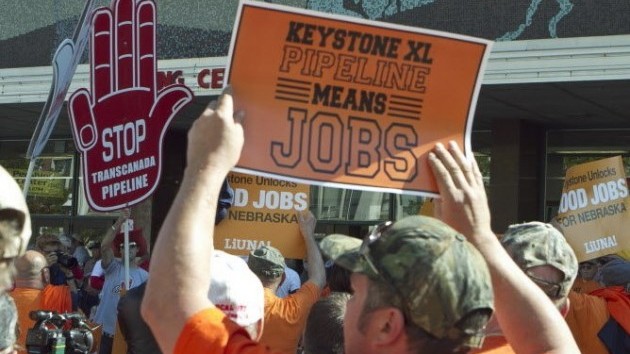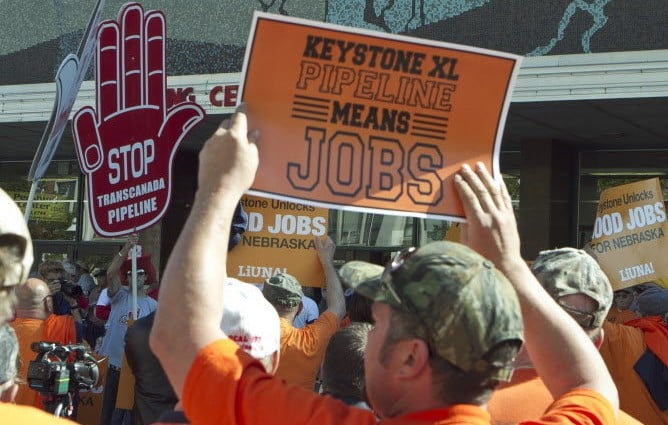

A new State Department review gave the Keystone XL pipeline the okay on Friday, finding no major potential environmental hazards. The report immediately turned up the pressure on the Obama administration to approve the long-awaited project, splintering the Democratic Party down union and environmental activist lines.
“This report from the Obama administration once again confirms that there is no reason for the White House to continue stalling construction of the Keystone XL Pipeline,” Senate Republican Leader Mitch McConnell said in a statement. “So, Mr. President, no more stalling — no more excuses.”
The minority leader also said in the statement that it was time for the president to use that pen he has been talking so much about lately.
Though the review could give President Obama the political cover he needs if he chooses to order construction of the pipeline, the issue has divided liberal Democrats. The unions, concerned about jobs in a sputtering economy, have asked the administration to approve the project, but radical environmental activist groups have opposed it.
The 1,179-mile pipeline would travel through the heartland, carrying oil derived from tar sands in western Canada to a hub in Nebraska, where it would then connect with already existing pipelines to carry more than 800,000 barrels of crude oil a day to refineries in Texas.
There are several key problems with the environmentalists’ argument.
First, the State Department said Canadian tar sands are likely to be developed regardless of whether or not the U.S. will be the benefactor of the pipeline, noting other options to get the oil from Canada to Gulf Coast refineries. Without the pipeline, the product may get to refineries by other means, including railroads, trucks and barges, which they claim would be even worse for climate change.
Approval from the State Department is necessary for the construction of the Keystone XL pipeline, because the pipeline crosses a U.S. border. The Environmental Protection Agency, or the EPA, as well as other related departments will have 90 days to opine on the report before the State Department gives Obama a final recommendation on whether the project is in U.S. national interest.
A final decision, however, is not expected before the summer.
The new report comes only days after Obama’s fifth State of the Union address, during which he again publicly announced his support for an “all-of-the-above” energy strategy, drawing from oil and natural gas to renewables, including wind and solar power.
But it would appear from the Obama administration policy that some policies are being pushed far more than others, despite him taking credit for all-time high oil production that is occurring despite administration policy, not due to it.
In remarks written by his environmental allies, activists said that supporting a policy of expanded oil and gas production is hypocritical for a president who wants to reduce pollution linked to global warming.
“We believe that continued reliance on an `all-of-the-above’ energy strategy would be fundamentally at odds with your goal of cutting carbon pollution,” the environmentalists wrote in a letter to Obama.
Obama blocked the Keystone XL pipeline back in January of 2012, claiming he did not have enough time for a fair review before a deadline imposed by congressional Republicans. Of course, that conveniently delayed the choice for him until after his re-election.
When Obama first rejected the pipeline, it didn’t go over well with our neighbors in Canada, as our northern neighbor relies on the U.S. for 97 percent of its energy exports. The pipeline is critical to Canada, which needs infrastructure in place to export its growing oil sands production, and they will simply give the economic and security benefit associate with the pipeline to China if we do not come partner with them. The northern Alberta region has the world’s third largest oil reserves in the world, with 170 billion barrels of proven reserves.
Obama made a token gesture in hopes of repairing relations with Canada when he proposed development of an Oklahoma-to-Texas line to ease an oil bottleneck at a storage hub in Cushing, Oklahoma. Oil just began flowing in that segment of the pipeline last week.
However, the 485-mile southern section of the pipeline operated by Calgary-based TransCanada did not require presidential approval because it does not cross a U.S. border.
The new State Department review is the latest environmental review and the fifth such review on the project since 2010. It underscores that development of tar sands in Alberta would create greenhouse gases, a State Department official said. However, they argue that other methods of transporting the oil — including rail, trucks and barges — would release more greenhouse gases that contribute to global warming than the pipeline.
In fact, U.S. and Canadian accident investigators just last week warned about the dangers of oil trains that transport crude oil from North Dakota and other states to refineries in the U.S. and Canada. The officials urged new safety rules, warning that a “major loss of life” could result from an accident involving the increasing use of trains to transport large amounts of crude oil.
Several high-profile accidents involving crude oil shipments — including a fiery explosion in North Dakota and an explosion that killed 47 people in Canada last year — have raised alarms.
Keystone XL would travel through Montana and South Dakota before reaching Nebraska. An existing spur runs through Kansas and Oklahoma to Texas.






